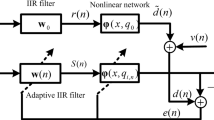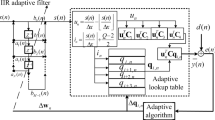Abstract
In this paper, a sign normalised least mean square algorithm (SNLMS) based on Hammerstein spline adaptive filter (HSAF) is proposed, which is derived by minimising the absolute value of the a posteriori error. The control points, collected in an adaptive lookup table which is interpolated by a local low-order polynomial spline curve and the tap weights of the linear filter are updated by using the direction information of the a posteriori error. The minimization of the absolute value of the a posteriori error reduces the impact of impulsive noises. The new algorithm is called HSAF-SNLMS and can be used to identify the Hammerstein-type nonlinear systems. Furthermore, the convergence performance analysis is carried out by considering the identification of the Hammerstein-type system and the computational complexity of the proposed algorithm is also analyzed. Simulation results in system identification demonstrate the proposed HSAF-SNLMS obtains more robust performance when compared with the existing spline adaptive filter algorithms in impulsive noise environments.



















Similar content being viewed by others
Explore related subjects
Discover the latest articles, news and stories from top researchers in related subjects.References
Guerin A, Faucon D, Bouquin-Jeannes RL (2003) Nonlinear acoustic echo cancellation based on Volterra filters. IEEE Trans Speech Audio Process 11(6):672–683
Patel V, George NV (2015) Nonlinear active control using spline adaptive filters. Appl Acoust 93:38–43
Patel V, Gandhi V, Heda S, George NV (2016) Design of adaptive exponential functional link network-based nonlinear filters. IEEE Trans Circuits Syst I Regul Pap 63(9):1434–1442
Patra JC, Meher PK, Chakraborty G (2009) Nonlinear channel equalization for wireless communication systems using Legendre neural networks. Signal Process 89(11):2251–2262
Schetzen M (1980) The Volterra and Wiener theories of nonlinear systems. Wiley, New York
Haykin S (2009) Neural networks and learning machines, 2nd edn. Pearson Publishing, Old Tappan, NJ
Giri F, Bai EW (2010) Block-oriented nonlinear system identification. Springer, Berlin
Scarpiniti M, Comminiello D, Parisi R, Uncini A (2013) Nonlinear spline adaptive filtering. Signal Process 93(4):772–783
Scarpiniti M, Comminiello D, Parisi R, Uncini A (2014) Hammerstein uniform cubic spline adaptive filtering: learning and convergence properties. Signal Process 100(7):112–123
Scarpiniti M, Comminiello D, Parisi R, Uncini A (2015) Novel cascade spline architectures for the identification of nonlinear systems. IEEE Trans Circuits Syst I Regul Pap 62(7):1825–1835
Bai EW (2003) Frequency domain identification of Wiener models. Automatica 39(9):1521–1530
Bai EW, Fu M (2002) A blind approach to Hammerstein model identification. IEEE Trans Signal Process 50(7):1610–1619
Ljung L (2006) Identification of nonlinear systems. In: 9th International conference on control, automation, robotics and vision (ICARCV), vol 1, pp 9–14
Shao T, Zheng YR, Benesty J (2010) An affine projection sign algorithm robust against impulsive interferences. IEEE Signal Process Lett 17(4):327–330
Kim JH, Chang JH, Nam SW (2013) Sign subband adaptive filter with L1Cnorm minimisation-based variable step-size. Electron Lett 49(21):1325–1326
Ni J, Chen X, Yang J (2014) Two variants of the sign subband adaptive filter with improved convergence rate. Signal Process 96(5):325–331
Wen P, Zhang S, Zhang J (2016) A novel subband adaptive filter algorithm against impulseive noise and its performance analysis. Signal Process 127(C):282–287
Wen P, Zhang J (2017) Robust variable step-size sign subband adaptive filter algorithm against impulseive noise. Signal Process 139:110–115
Bhotto ZA, Antoniou A (2013) A family of shrinkage adaptive-filtering algorithms. IEEE Trans Signal Process 61(7):1689–1697
Zhang S, Zhang J, Han H (2017) Robust shrinkage normalized sign algorithm in an impulsive noise environment. IEEE Trans Circuits Syst II Express Br 64(1):91–95
Guan S, Li Z (2017) Normalised spline adaptive filtering algorithm for nonlinear system identification. Neural Process Lett 5:1–13
Scarpiniti M, Comminiello D, Parisi R, Scarano G, Parisi R, Uncini A (2016) Steady-state performance of spline adaptive filters. IEEE Trans Signal Process 64(4):816–828
George NV, Panda G (2012) A robust filtered-s LMS algorithm for nonlinear active noise control. Appl Acoust 73(8):836–841
Lu L, Zhao H (2017) Active impulsive noise control using maximum correntropy with adaptive kernel size. Mech Syst Signal Process 87:180–191
Kurian NC, Patel K, George NV (2017) Robust active noise control: an information theoretic learning approach. Appl Acoust 117:180–184
Acknowledgements
This research was supported by the National Natural Science Foundation of China under Grant 61501119.
Author information
Authors and Affiliations
Corresponding author
Additional information
Publisher's Note
Springer Nature remains neutral with regard to jurisdictional claims in published maps and institutional affiliations.
Rights and permissions
About this article
Cite this article
Liu, C., Zhang, Z. & Tang, X. Sign Normalised Hammerstein Spline Adaptive Filtering Algorithm in an Impulsive Noise Environment. Neural Process Lett 50, 477–496 (2019). https://doi.org/10.1007/s11063-019-09996-6
Published:
Issue Date:
DOI: https://doi.org/10.1007/s11063-019-09996-6




